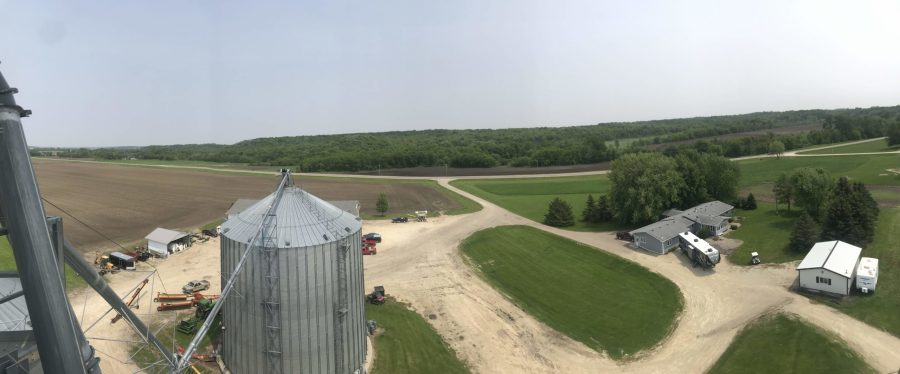COVID-19 has created a bleak economic outlook for Rice County farmers. The pandemic has paralyzed the global economy and disrupted critical supply chains, preventing farm products from seamlessly reaching consumers. Coming at the heel of a year when American farmers suffered from President Donald Trump’s trade war with China, the virus has prolonged a period of economic uncertainty for this key demographic. Farmers in Southeastern Minnesota are certainly feeling the pressure.
Earlier this month, future prices for commodities like corn and soybeans dropped by 13.5% and 6.8% respectively, according to the University of Illinois. This economic data affected the decisions farmers made during the planting season that recently came to a finish.
“It affected our decisions a little bit,” said David Estrem, a farmer in Nerstrand, Minnesota, who raises hogs and grows corn and soybeans. “We were more conscious of over planting due to the lower prices, and also because of just how difficult it is to borrow money in this economic climate.”
The national lockdown has shuttered restaurants, hotels, and schools across the United States, leaving farmers without key purchasers of their goods. 60% of domestically produced bacon, for example, is purchased by restaurants.
For farming families like the Estrems, the closure of food services was already making life difficult. Then, even more bad news came in early April: decisions made by plant operators across the Midwest to shutdown their pork processing facilities due to positive COVID-19 tests among employees.
Some pork processors, like the Smithfield plant in Sioux Falls, South Dakota, remained shutdown through May, while others continued to operate, albeit at a significantly lower production level due to social distancing measures. At full capacity, pork processing plants require workers to be in close proximity to one another, which prompted fears the plants could become hotbeds for virus transmission.
Suddenly, processing plants are no longer taking in as many hogs, either because they are closed or unable to keep up with supply while maintaining social distance. This has forced farmers to leave tens of thousands of their livestock on feedlots across America.
Hogs can grow up to 375 pounds before plants’ machinery is no longer adequate to process them. When a hog grows above this threshold, it faces euthanasia, as it is no longer economically feasible to continue feeding hogs farmers know won’t be accepted to a processing plant. Farms can only afford to house so many hogs, and they are expensive to feed.
“It’s impacted us tremendously,” said Estrem, referring to the recent chaos surrounding pork processing. “We’re growing the hogs a lot heavier than we want.”
Earlier this month, the Star Tribune reported 10,000 pigs were being euthanized each day in the state of Minnesota.
“We’ve been fortunate enough to not have to euthanize any hogs at this point,” said Estrem. Over the last month, the Estrems have sent their hogs to locker plants (small local processors who carve up ham or pork and sell it directly to individual customers).
Not every farmer has been able to use their connections like the Estrems. Locker plants, after all, are not always a viable option. According to Estrem, they are typically booked up to two months in advance. Now, they are operating overtime to help farmers who cannot get their hogs to market soon enough.
Along with these issues comes a massive amount of food waste. According to The New York Times, many farmers are donating some of their surplus commodities to food banks, but there is only so much perishable food that can be refrigerated in these limited spaces.
“People are going hungry for no reason,” Estrem says. The disruption in the supply chain frustrates him not only because it has put his own economic interests in jeopardy, but because as a farmer he boasts: “We take pride in feeding America.”
The prospects for dairy farmers are grim as well. Bob Duban, a Denison farmer who produces dairy, said his family hasn’t dumped any milk — but he worries about what might come next. Prior to the pandemic, the dairy market was nearing saturation, with dairy farmers already exiting the market to begin with.
“The low dairy prices now make it tough for farmers to pay their land rent,” noted Duban. The prices Duban is getting for milk are about nine dollars under the cost of production per one hundred pounds, he noted. “Dairy has been affected with low prices for the past three years now, but especially with COVID-19, many farmers have been forced to eliminate a fourth of their production, while some people have culled 25% of their herds just to cut back.”
Dairy Farmers of America, the country’s largest dairy cooperative, estimated in April that farmers are dumping as much as 3.7 million gallons of milk a day. Cows need to be milked multiple times per day, whether there are buyers in line or not.
As far as Duban recalls, he has not experienced an episode so ravaging to American agriculture since the economic recession of the early 1980s, “when the product values were down, the interest rates were so tremendously high and the banks were foreclosing on people.”
The pandemic has not directly affected the Duban’s planting decisions, but it has for neighboring farmers. “Normally they would be planting half corn and half soybeans, but a lot of them are planting more beans now,” Duban said. “Not necessarily because they will sell better, but because soybeans don’t have fertilizer costs.” Minnesota is the third largest exporter of soybeans and the fourth-largest exporter of corn in the United States.
Since the pandemic has kept Americans at home with their automobiles off the roads, domestic demand for ethanol, a key component of fuel-efficient gasoline, has plummeted. According to the Minnesota Corn Grower’s Association, the majority of the corn farmers sold last year (34.5%) went to ethanol producers. If stay-at home orders are reintroduced this summer, farmers could really begin to feel the economic repercussions.
To provide farmers with some aid, the Trump administration initiated a $19 billion dollar package to benefit farmers impacted by the pandemic. Of that total, three billion is slated to go towards a mass government purchase of dairy, while the other $16 billion will be directly distributed to farmers in need. But, as David Estrem put it: “These payments are only a band-aid.”
At the time of their interviews, the federal government was yet to directly provide the Estrems or the Duban family with any economic assistance. The last time they received payment from the government was when the Trump Administration rolled out a relief package for farmers impacted by tariffs from the trade war with China.
At the state level, Minnesota Governor Tim Walz signed a bill into action on May 19 preventing farm foreclosures until December 1. This legislation will extend the deadline of the Farmer-Lender Mediation Act, which stipulates that any creditor foreclosing on agricultural debt of $15,000 or more has to provide legal notice of their right to a neutral state mediator.
The aim is to provide a level of stability for farmers severely impacted by the pandemic, who normally only have 90 days to reach an agreement with their creditors.
Denis Espinoza, a retired hay producer in Northfield with many contacts in agriculture, believes that the government still has a long way to go in providing help.
“They should be able to control the prices, see who is making the money in this situation, and address why it’s not getting to the farmer, because the farmers are the ones who need prices to get better on their end, so they can keep producing,” said Espinoza.
Although economic conditions for local farmers are contingent on the events which will unfold in the next couple months, much of the damage has already been done. The next step will likely include further cooperation from the government through either stimulus payments or the granting of increased flexibility to farmers making payments on loans and rent.
In the long run, farmers may need to rethink their distribution and production methods if another wave of the virus emerges or pandemics similar to COVID-19 become more common down the road.
“There’s a lot of farmers going out of business, and it’s going to be a long recovery,” said Espinoza. “It’s not going to be easy.”












